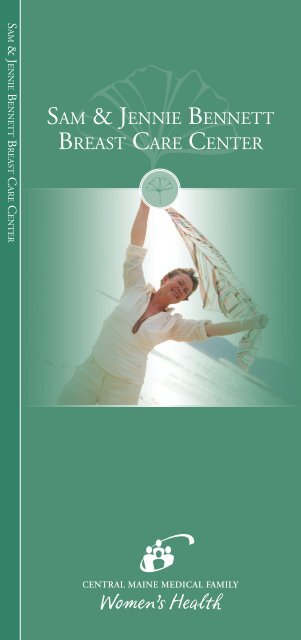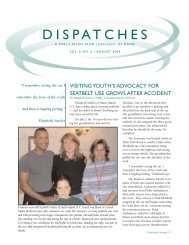Sam & Jennie Bennett Breast Care Center - Central Maine Medical ...
Sam & Jennie Bennett Breast Care Center - Central Maine Medical ...
Sam & Jennie Bennett Breast Care Center - Central Maine Medical ...
Create successful ePaper yourself
Turn your PDF publications into a flip-book with our unique Google optimized e-Paper software.
<strong>Sam</strong> & <strong>Jennie</strong> <strong>Bennett</strong> BreaSt <strong>Care</strong> <strong>Center</strong><br />
<strong>Sam</strong> & <strong>Jennie</strong> <strong>Bennett</strong><br />
BreaSt <strong>Care</strong> <strong>Center</strong>
d<br />
<strong>Central</strong> maine mediCal <strong>Center</strong>’S<br />
<strong>Sam</strong> & <strong>Jennie</strong> <strong>Bennett</strong> BreaSt <strong>Care</strong><br />
<strong>Center</strong> iS a private plaCe where a woman<br />
Can find ComprehenSive BreaSt <strong>Care</strong><br />
ServiCeS Suiting her individual needS.<br />
loCated in Suite 103 of the 12 high<br />
Street mediCal offiCe Building, whiCh iS<br />
direCtly ConneCted to CmmC, the<br />
<strong>Bennett</strong> <strong>Center</strong> offerS a numBer of<br />
ServiCeS in one loCation.<br />
the <strong>Sam</strong> & <strong>Jennie</strong> <strong>Bennett</strong> BreaSt<br />
<strong>Care</strong> <strong>Center</strong> Can help a woman find<br />
Strength and ConfidenCe in Coping<br />
with BreaSt diSeaSe.
the team<br />
The <strong>Bennett</strong> <strong>Breast</strong> <strong>Care</strong> <strong>Center</strong> team includes doctors,<br />
medical imaging technologists, therapists, nurses and<br />
an outstanding support staff. Together, these professionals<br />
assist women through the range of appropriate<br />
services, including diagnosis, treatment and after-care.<br />
mammogram<br />
Mammography is a low-level x-ray of the breast that<br />
can detect lumps or changes too small to be felt manually.<br />
Specially trained female technologists perform<br />
mammogram studies, and most can be completed in<br />
about 20 minutes.<br />
About Mammography<br />
There are two types of mammography: diagnostic and<br />
screening.<br />
Screening mammography detects breast changes in<br />
women who have no signs of breast cancer. A woman<br />
can self-refer for a screening mammogram.<br />
A diagnostic mammogram is for a woman who has<br />
lumps, pain, nipple discharge, or other unusual breast<br />
changes. This is most often performed on women after<br />
the age of 30 and requires an order from a physician or<br />
other clinician.<br />
There are two mammography imaging technologies:<br />
film screen and digital. The <strong>Bennett</strong> <strong>Breast</strong> <strong>Care</strong><br />
<strong>Center</strong> continues to use the film screen method while<br />
awaiting further technical developments in digital<br />
mammography.<br />
Obtaining useful mammography images requires<br />
compression of the breast tissue. This may be uncomfortable,<br />
but it is absolutely essential. Compression improves<br />
the accuracy of the test and reduces the amount<br />
of radiation needed to get a clear picture. Compression<br />
is not dangerous and does not cause any breast tissue<br />
damage.
MammoPad®<br />
The <strong>Sam</strong> and <strong>Jennie</strong> <strong>Bennett</strong> <strong>Breast</strong> <strong>Care</strong> <strong>Center</strong> is<br />
certified as a Softer Mammogram Provider, a distinction<br />
awarded only to an elite group of healthcare<br />
facilities. This means the <strong>Bennett</strong> <strong>Center</strong> provides a soft<br />
foam cushion, called MammoPad®, for each woman’s<br />
personal use during every screening mammogram.<br />
A female breast surgeon designed the MammoPad<br />
breast cushion. It is FDA-approved, does not impair<br />
image quality, and makes it easier for you to relax and<br />
be warm and comfortable during your exam. And all<br />
this helps our highly skilled mammography technologists<br />
achieve the best possible mammogram.<br />
As a Softer Mammogram Provider, the <strong>Bennett</strong> <strong>Center</strong><br />
ensures that your mammogram is warm and comfortable.<br />
It’s one way we provide the compassionate care<br />
you deserve.<br />
To schedule a Softer Mammogram, or if you have questions,<br />
call 795-2100.<br />
ultraSound<br />
<strong>Breast</strong> ultrasound is an imaging technique that uses<br />
high frequency sound waves to scan the breast to locate,<br />
measure and evaluate abnormal changes or lesions<br />
found through mammography.<br />
Ultrasound can determine if a breast lump is solid (a<br />
benign or malignant tumor) or filled with fluid (cyst).<br />
When used in addition to mammography in women<br />
with dense breasts, ultrasound improves the doctor’s<br />
ability to detect breast cancer or confirm a benign<br />
tumor. Because breast ultrasound is not as sensitive and<br />
specific for diagnosing breast cancer as mammography,<br />
it is not used routinely as a screening method. But it<br />
is very helpful in evaluating palpable (felt on examination)<br />
masses in young women.
duCtogram<br />
A ductogram is a mammography procedure that searches<br />
for small growths in a specified breast duct. It is used<br />
to evaluate the cause of clear or bloody spontaneous<br />
(caused without known stimulation) nipple discharge<br />
that is unilateral (from one breast) and from a single<br />
duct (identified from only one area on the nipple).<br />
Ductography is a well-tolerated procedure that involves<br />
inserting a tiny catheter tip into the duct and inserting<br />
a very small amount of liquid contrast material. A<br />
mammogram then takes a picture of the duct system as<br />
outlined by the material. This image may reveal filling<br />
defects (areas where the contrast material doesn’t show<br />
up) that indicate the presence of a growth. The most<br />
common being a benign (non-cancerous), polyp-type<br />
growth in the lining of the breast duct called a papilloma.<br />
mri<br />
Magnetic resonance imaging (MRI) may be used in<br />
combination with mammography in women with very<br />
dense breasts who are at high risk of hereditary breast<br />
cancer. MRI produces high quality images generated by<br />
using a magnetic field and radio waves.<br />
MRIs are performed at <strong>Central</strong> <strong>Maine</strong> Imaging <strong>Center</strong>,<br />
located at 287 Main Street Plaza in Lewiston, just<br />
across the street from <strong>Central</strong> <strong>Maine</strong> <strong>Medical</strong> <strong>Center</strong>.
BreaSt BiopSy ServiCeS<br />
<strong>Breast</strong> cyst aspiration<br />
<strong>Breast</strong> Cyst Aspiration is a simple, inexpensive procedure<br />
that can be completed in a matter of minutes with<br />
minimal discomfort to the patient. The aspirated fluid<br />
is tested for hidden blood and is not routinely sent to<br />
the laboratory for analysis. The skin where the needle<br />
is inserted is anesthetized with Novacaine. The test is<br />
usually performed on a symptomatic cyst that is painful<br />
or very large.<br />
Fine needle aspiration<br />
Fine needle aspiration is a procedure similar to cysts<br />
aspiration, but is performed on breast tumors. A very<br />
fine needle is inserted and breast cells are withdrawn.<br />
The cells are analyzed to determine if they are benign or<br />
malignant (cancerous).<br />
Core needle biopsy<br />
Core needle biopsy is a highly accurate diagnostic<br />
procedure for identifying a malignant tumor without<br />
the need for surgery. This procedure is performed with<br />
a hand-held needle that removes small tissue samples<br />
from the area. Often the core needle is guided into<br />
position by ultrasound and can be performed by either<br />
a surgeon or radiologist. The patient leaves with a sterile-strip<br />
over the wound and an ice pack. The procedure<br />
is well tolerated by most women.<br />
Stereotactic needle biopsy<br />
Stereotactic needle biopsy is a sophisticated technique<br />
for checking extremely small lumps or calcium deposits<br />
that cannot be felt but are detected on mammography.<br />
This procedure requires the patient lay face down on a<br />
table with an opening that allows the breast to be suspended.<br />
A special computer program, using informa-
tion obtained with mammography equipment, guides<br />
the biopsy needle into position. The needle is inserted<br />
through an incision so small that it does not require<br />
stitches. The needle retrieves enough breast tissue for<br />
the pathologist to determine if the tumor is malignant<br />
or benign.<br />
Needle localization<br />
Sometimes very small lumps found on a mammogram<br />
can be hard to locate and biopsy. To target the exact location<br />
of such a small lump, a special needle, with a fine<br />
hooked wire inside, is guided into place with the use<br />
of mammography. When the needle reaches the exact<br />
site of the lump, the hooked wire is fixed into the area<br />
as a marker. The surgeon can then remove the lesion<br />
without removing a large amount of normal tissue.<br />
Sentinel node biopsy<br />
Determining if lymph nodes are cancerous is an important<br />
part of treatment. Sentinel node biopsy requires<br />
the removal of just a few nodes that lie near the original<br />
tumor. If the sentinel lymph nodes are negative (no<br />
cancer found in them), then the further lymph node<br />
removal is avoided. In some cases, the sentinel node<br />
biopsy may be followed by more extensive surgery.<br />
Ductal lavage<br />
Ductal lavage is a method of rinsing the milk duct to<br />
obtain cells for analysis. It is only used with standard<br />
breast cancer detection methods such as mammography,<br />
clinical exams, and breast self-exams for women<br />
identified as high risk for breast cancer. Knowing<br />
whether she has abnormal cells in her breast can help a<br />
woman and her doctor make decisions about ways to<br />
reduce her breast cancer risk.
BreaSt health eduCation<br />
Self breast exam (BSE) instruction<br />
At the <strong>Bennett</strong> <strong>Center</strong>, a skilled practitioner is available<br />
for individual consultation and instruction for selfbreast<br />
exam. Silicone models are available to test patient<br />
skills.<br />
Edu-<strong>Care</strong> instruction sheets<br />
The <strong>Bennett</strong> <strong>Breast</strong> <strong>Care</strong> <strong>Center</strong> has a full complement<br />
of instructional and fact sheets for a host of breast<br />
abnormalities ranging from minor fibrocystic changes<br />
to breast cancer care.<br />
Gail Risk Assessment<br />
A risk factor is a trait that increases a woman’s chances<br />
of developing a disease. Not everyone who has a risk<br />
factor will get the disease. The <strong>Bennett</strong> <strong>Breast</strong> <strong>Care</strong><br />
<strong>Center</strong> calculates a Gail Risk Assessment on all women<br />
who have mammograms at the center. This information<br />
is forwarded to the ordering physician who will discuss<br />
the findings with their patients and make appropriate<br />
referrals on women who are identified as high risk.<br />
Genetic counseling and testing for breast cancer<br />
This service is arranged by the <strong>Central</strong> <strong>Maine</strong> Comprehensive<br />
Cancer <strong>Center</strong> staff.
lymphedema eduCation<br />
and treatment<br />
Lymphedema is the swelling caused by the buildup<br />
of lymphatic fluid in the tissues. It is a chronic and<br />
progressive disorder that usually worsens over time if<br />
not treated. With education about risk factors and by<br />
exercising caution after an injury to the lymph nodes,<br />
patients can sometimes prevent this difficult condition<br />
from developing. The <strong>Bennett</strong> <strong>Center</strong>’s nationally<br />
certified lymphedema specialists provide lymphedema<br />
management services at Outpatient Rehabilitation<br />
Services, located at 12 High Street, Suite 102, near the<br />
<strong>Bennett</strong> <strong>Center</strong>.<br />
BreaSt proSthetiC ServiCeS<br />
The <strong>Sam</strong> and <strong>Jennie</strong> <strong>Bennett</strong> <strong>Breast</strong> <strong>Care</strong> <strong>Center</strong>’s<br />
Prosthetic Service is not only about the restoration of<br />
a woman’s natural body symmetry and balance, but<br />
about the restoration of self-confidence and self-esteem.<br />
This service is uniquely suited to support, encourage,<br />
and empower women struggling with the aftermath of<br />
breast cancer as well as problems caused by congenital<br />
breast defects or plus-sized breasts. Whether a woman<br />
has undergone a mastectomy, is a nursing mother,<br />
has a breast defect, or is having difficulty in finding<br />
high-quality plus-size bras, the <strong>Bennett</strong> <strong>Center</strong> has an<br />
experienced, specially trained and certified prosthetic<br />
fitter to help.
Something you Should know<br />
The <strong>Maine</strong> <strong>Breast</strong> and Cervical Health Program<br />
(MBCHP) covers the cost of services for women 40<br />
years of age and over if they meet certain conditions<br />
regarding insurance coverage and financial resources. To<br />
see if you qualify or for more information call:<br />
1-800-350-5180 and press 1<br />
or call the <strong>Bennett</strong> <strong>Breast</strong> <strong>Care</strong> <strong>Center</strong> at<br />
795-2100 or toll free at 1-888-240-6100
12 HigH Street, Suite 103, LewiSton<br />
795-2100 or 1-877-664-9200<br />
www.cmmc.org






